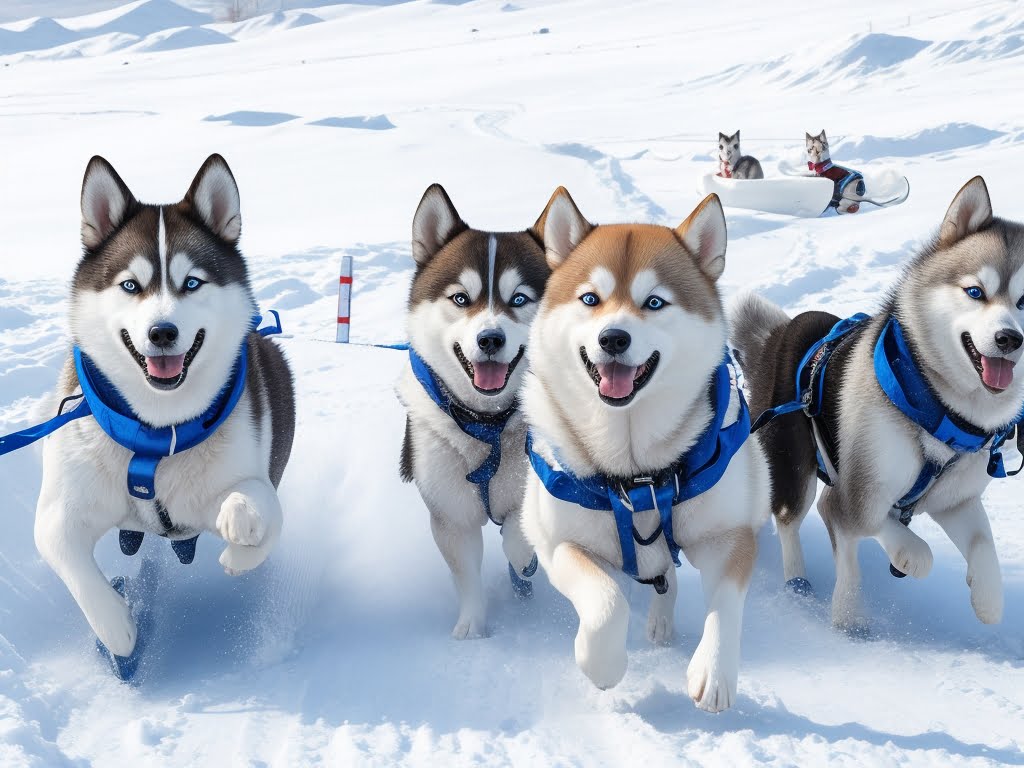Step into the exhilarating world of dog sledding as you embark on a thrilling adventure like no other. In this captivating article, we will take you on a journey into the exhilarating sport of dog sledding, giving you a taste of the excitement and adrenaline that comes with mushing through snowy landscapes. From learning about the fascinating history and traditions of dog sledding to discovering the awe-inspiring Iditarod race, get ready to explore this unique winter activity. And if you’re feeling particularly adventurous, we’ll even provide you with opportunities to visit dog sled camps and experience the magic firsthand. Get ready to embrace the thrill of the sled and let the dogs guide you through a winter wonderland.
Book your Sledding Adventure NOW
Table of Contents
ToggleThe History of Dog Sledding
Origins of dog sledding
Dog sledding has a rich and fascinating history that dates back thousands of years. It is believed to have originated in the Arctic regions, where indigenous cultures relied on dogs to transport people and goods across the snow-covered landscapes. These early sled dogs were crucial for survival in harsh conditions and played a significant role in the daily lives of Arctic communities.
Traditional uses of dog sledding
In ancient times, dog sledding was an essential means of transportation, providing a reliable way to traverse long distances across frozen terrain. Indigenous peoples relied on dog sledding for hunting, trading, and even for cultural ceremonies. The sled dogs served as both companions and working animals, demonstrating their loyalty and endurance in arduous conditions.
Dog sledding as a sport
Over time, dog sledding evolved from a practical mode of transport into a popular sport enjoyed by many. It gained recognition as a competitive activity in the late 19th century, with the first formal races taking place in Scandinavia. The sport quickly spread to other regions, including North America, where it captured the imagination of adventurers and outdoor enthusiasts.
The Iditarod: The Last Great Race on Earth
Overview of the Iditarod
The Iditarod Trail Sled Dog Race, often referred to as the “Last Great Race on Earth,” is a grueling and iconic dog sledding competition held annually in Alaska. Covering a distance of approximately 1,000 miles, the race takes mushers and their teams of sled dogs through rugged terrain, freezing temperatures, and challenging weather conditions. It is considered the ultimate test of endurance and skill for both mushers and their faithful canine companions.
Historical background of the Iditarod
The Iditarod race was inspired by the historic dog sledding mail routes that were crucial for communication and transportation during Alaska’s early days. These mail routes, known as the Iditarod Trail, were used by mushers to deliver mail and supplies to remote communities. The modern-day Iditarod race was first organized in 1973 to commemorate this historic trail and celebrate the role of sled dogs in Alaska’s history.
Significance of the race
The Iditarod has become an iconic event that showcases the indomitable spirit of both human and canine athletes. It is a celebration of Alaska’s heritage and a testament to the enduring bond between humans and their sled dogs. Beyond the sheer thrill of competition, the Iditarod also serves to preserve and promote the traditions of dog sledding, ensuring that this ancient art form continues to captivate and inspire future generations.
Training Sled Dogs
Selecting the right breed for sledding
When it comes to selecting sled dogs, certain breeds are better suited for the demands of the sport. The Alaskan Malamute, Siberian Husky, and the Alaskan Husky are among the most commonly used breeds in dog sledding. These dogs possess the physical attributes, such as endurance and strength, necessary for pulling sleds over long distances. Additionally, their thick coats provide insulation against the cold temperatures encountered during sledding trips.
Training methods for sled dogs
Training sled dogs requires patience, consistency, and positive reinforcement. The process begins when the dogs are puppies, introducing them to basic commands and socializing them with other dogs and humans. As they grow older, they are gradually introduced to pulling a sled, starting with lightweight loads and progressing to heavier loads over time. Training sessions include teaching the dogs to respond to voice and hand signals, as well as working as a team to maintain speed and direction.
Physical conditioning of sled dogs
Sled dogs are remarkable athletes, capable of covering vast distances at high speeds. To ensure their optimal performance, mushers carefully condition their dogs through regular exercise and a nutritious diet. Dogs are trained to build strength, endurance, and stamina through activities like long runs and pulling weighted sleds. Proper rest and recovery are also essential components of their conditioning routine, allowing them to maintain peak physical fitness throughout the season.
The Equipment Used in Dog Sledding
Sled design and components
The design of sleds used in dog sledding has evolved over time to improve efficiency and durability. Modern sleds are typically made of lightweight, yet strong materials, such as aluminum or carbon fiber. They feature a long, narrow profile to minimize drag and maximize speed. Sleds also have wide runners for stability and braking systems to ensure control when going downhill. Additionally, sleds are equipped with storage compartments to carry essential gear and supplies for the musher and the dogs.
Harnesses and lines
Harnesses and lines are crucial components of dog sledding equipment, connecting the dogs to the sled and allowing the musher to maintain control. The harnesses, typically made of durable nylon or leather, are specifically designed to distribute the pulling force evenly across the dog’s body, reducing strain and preventing injuries. The lines, made of strong and lightweight materials, provide the connection between the dogs and the sled, allowing the musher to communicate commands and guide the team effectively.
Essential gear for the musher
Mushers rely on a variety of gear to ensure their comfort, safety, and efficiency during dog sledding expeditions. This includes insulated clothing and footwear to protect against the extreme cold, as well as goggles and face masks to shield against wind and snow. Other essential gear includes navigational tools, such as maps and compasses, along with emergency equipment like first aid kits and communication devices. Adequate food, water, and shelter provisions are also essential for the musher’s well-being during long journeys.
Dog Sledding Techniques and Commands
Basic commands for sled dogs
Clear and concise commands are crucial for effectively communicating with sled dogs during a race or expedition. Common commands used in dog sledding include:
- “Hike!” or “Let’s go!”: Start running
- “Whoa!”: Stop
- “Gee!”: Turn right
- “Haw!”: Turn left
- “Easy!”: Slow down
- “On by!”: Pass other teams or distractions
- “Line out!”: Stand still and stretch the tug lines
These commands, combined with voice and hand signals, enable the musher to navigate and guide the sled dogs throughout the journey.
Techniques for maneuvering the sled
Maneuvering a sled requires skill and finesse, particularly when navigating challenging terrain or avoiding obstacles. To turn the sled, the musher shifts their body weight and applies pressure on the runners with their feet, effectively steering the sled in the desired direction. When going downhill, the musher may use a foot brake or drag mat to control the speed. Uphill sections may require the musher to assist the dogs by running alongside the sled and providing additional pulling power.
Safety protocols during sledding
Safety is of utmost importance in dog sledding, both for the musher and the dogs. Mushers should be well-versed in cold weather survival techniques, including recognizing signs of hypothermia or frostbite and how to treat them. They should also be prepared for emergencies, carrying appropriate safety equipment and knowledge of how to handle situations such as broken sleds or injured dogs. Regular equipment checks, proper trail etiquette, and adherence to race rules further contribute to a safe and enjoyable dog sledding experience.
Dog Sled Camps: The Ultimate Experience for Dog Lovers
Overview of dog sled camps
Dog sled camps offer a unique and immersive experience for dog lovers to learn about the world of mushing and interact with sled dogs up close. These camps are typically located in scenic winter destinations, providing participants with the opportunity to experience the thrill of dog sledding in a controlled and educational environment. Whether it’s a day trip or a multi-day adventure, dog sled camps offer a glimpse into the world of sled dogs and the remarkable bond between mushers and their teams.
Learning opportunities at dog sled camps
At dog sled camps, participants can learn about various aspects of dog sledding, including the history of the sport, dog care and training, and the equipment used. They may have the chance to witness demonstrations of sled dog teams in action, observe the training process, and even try their hand at mushing under the guidance of experienced instructors. Additionally, dog sled camps often provide educational presentations on topics such as the importance of responsible tourism and the role of sled dogs in conservation efforts.
Hands-on experiences with sled dogs
One of the highlights of dog sled camps is the opportunity to interact with sled dogs on a personal level. Participants can help groom and care for the dogs, learning about their unique personalities, and forming bonds with individual dogs. They may have the chance to assist with harnessing and hitching the dogs to the sled, gaining firsthand experience in preparing a team for a sledding adventure. These hands-on experiences not only deepen the appreciation for the dogs’ capabilities but also foster a deeper connection to the world of mushing.
The Role of the Musher
Responsibilities of the musher
The role of the musher extends beyond simply standing on the sled and giving commands. Mushers have a range of responsibilities, including the care and well-being of their dogs, navigating the trail, maintaining the sled, and managing supplies and equipment. They must ensure the dogs receive proper rest, nutrition, and hydration throughout the journey. Additionally, mushers play a critical role in making strategic decisions, such as when to push the team or take breaks, to optimize performance and safety.
Building a bond with the dogs
A strong bond between the musher and their dogs is essential for successful teamwork in dog sledding. Mushers spend countless hours with their dogs, developing trust and a deep understanding of each dog’s strengths and weaknesses. They form strong emotional connections with their team, recognizing the nuances of their body language and individual personalities. This bond is essential for effective communication and mutual support during the challenges of long-distance races or expeditions.
Mental and physical challenges of mushing
Mushing is a physically and mentally demanding activity that requires resilience, adaptability, and problem-solving skills. The musher must be prepared to face unpredictable weather conditions, challenging terrain, and the physical strain of long hours on the sled. They must also possess mental strength to make quick decisions under pressure, navigate unfamiliar territory, and deal with unexpected obstacles. As a result, mushing is a deeply rewarding pursuit that tests both the musher’s physical endurance and their ability to overcome adversity.
The Thrill of Dog Sledding Races
Types of dog sledding races
Dog sledding races come in various formats, ranging from short sprints to endurance races covering hundreds of miles. The most famous races include the Iditarod, the Yukon Quest, and the Finnmarksløpet. These races attract top mushers from around the world and are known for their challenging conditions and spectacular scenery. Other races, such as the Fur Rendezvous Open World Championship Sled Dog Race, offer opportunities for both professional and amateur mushers to compete and showcase their skills.
Strategies for winning races
Winning a dog sledding race requires a combination of careful planning, strategic decision-making, and exceptional teamwork between musher and dogs. Successful mushers must consider factors like dog selection, training methods, equipment choices, and race strategy. They analyze the terrain and weather conditions to optimize their team’s performance and plan their rest stops strategically. Additionally, a deep understanding of their dogs’ capabilities, strengths, and limitations is crucial for pacing the race and making real-time adjustments.
Famous dog sledding races around the world
Dog sledding races have gained global recognition and become integral to the cultural fabric of many regions. In addition to the Iditarod, the world’s most prestigious dog sledding race, there are other notable races held in different countries. The Yukon Quest, a 1,000-mile race between Alaska and Canada’s Yukon Territory, is renowned for its challenging terrain and tough conditions. The Finnmarksløpet in Norway is Europe’s longest dog sledding race, attracting top mushers from around the world. These races, among many others, capture the hearts of enthusiasts worldwide and showcase the breathtaking beauty of the sport.
Dog Sledding Etiquette and Responsible Tourism
Respecting sled dogs and their welfare
Responsible tourism in dog sledding includes treating sled dogs with respect, ensuring their welfare, and advocating for their well-being. Visitors should understand the needs and limitations of sled dogs, refraining from actions that may cause unnecessary stress or harm. Approaching dogs calmly and quietly, refraining from sudden movements and loud noises, and understanding the signs of dog behavior are essential. Contributing to organizations that prioritize the health and care of sled dogs is another way to support responsible tourism in this field.
Following trail etiquette
Dog sledding, particularly in popular race and tour areas, requires adherence to trail etiquette to maintain safety and preserve the natural environment. This includes following designated routes, respecting posted speed limits, and yielding to oncoming traffic when appropriate. Additionally, proper waste management, such as cleaning up after dogs and disposing of waste responsibly, helps protect the environment and ensures that dog sledding remains a sustainable and ecologically conscious activity.
Supporting ethical dog sledding operations
When engaging in dog sledding experiences or booking tours, it is important to support ethical operations that prioritize the well-being of sled dogs. This includes conducting research and selecting operators that provide proper care, nutrition, and veterinary support for their dogs. Ethical operators also ensure that their dogs receive adequate rest periods and are not overworked. By choosing responsible and ethical dog sledding providers, visitors can actively contribute to the welfare and conservation of sled dogs.
Challenges and Controversies in Dog Sledding
Climate change and its impact on dog sledding
As the effects of climate change become more pronounced, the traditional practice of dog sledding faces significant challenges. Rising temperatures, decreased snowfall, and changing weather patterns pose risks to the safety and welfare of sled dogs, as well as the viability of dog sledding as a cultural tradition. Efforts are underway to mitigate these challenges, such as adapting sled designs, modifying training techniques, and exploring alternative forms of transportation. However, climate change remains a pressing concern that requires continued attention and action.
Treatment of sled dogs in controversial cases
Controversial cases involving the mistreatment or neglect of sled dogs have shed light on the need for strong regulations and ethical practices within the dog sledding industry. These cases have prompted increased scrutiny and calls for improved standards of care. Responsible operators prioritize the physical and mental well-being of their dogs, maintain transparent operations, and engage in ongoing education and advocacy to elevate the standards of dog sledding. By addressing and rectifying any issues related to the treatment of sled dogs, the industry can continue to evolve and grow.
Balancing tradition with modern practices
As dog sledding evolves, a delicate balance must be struck between preserving the rich tradition and heritage of the sport while embracing modern practices and advancements. New technologies, improved equipment, and evolving training methodologies offer opportunities to enhance the efficiency, safety, and sustainability of dog sledding. At the same time, it is crucial to honor the historical significance and cultural importance of dog sledding, ensuring that its essence and spirit are not compromised. By embracing innovation while staying grounded in tradition, the world of dog sledding can continue to captivate and inspire generations to come.
In conclusion, dog sledding is an extraordinary pursuit that blends history, culture, athleticism, and the inherent bond between humans and animals. From its ancient origins as a means of transportation to its evolution as a thrilling sport, dog sledding has woven itself into the fabric of various cultures around the world. Whether competing in renowned races or experiencing the magic of dog sled camps, enthusiasts and visitors have the opportunity to delve into this captivating world and witness the awe-inspiring capabilities of sled dogs. By embracing responsible tourism, advocating for the welfare of sled dogs, and navigating the challenges of a changing world, dog sledding can continue to thrive while honoring its profound legacy.





